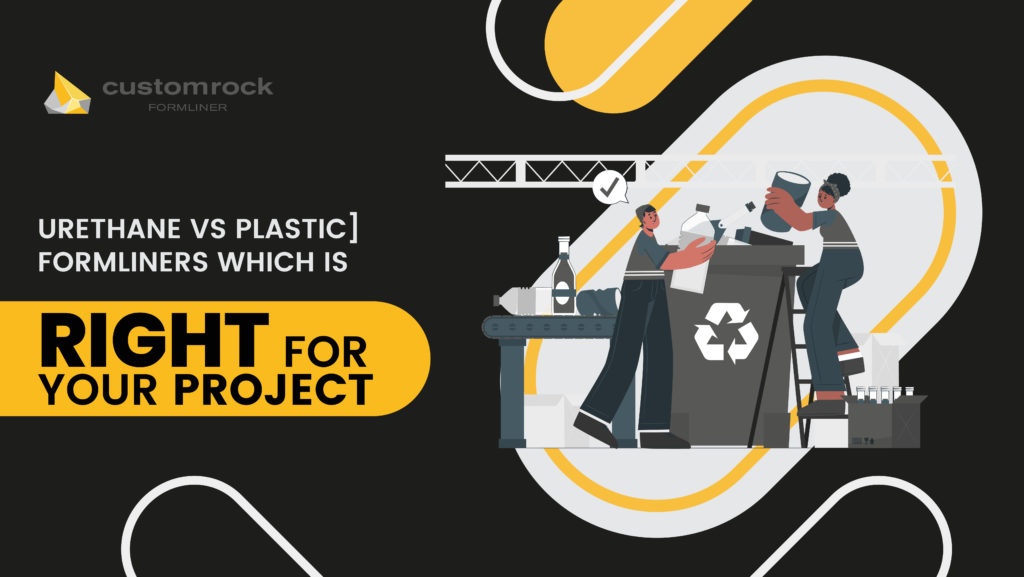TL: DR
When selecting the right formliner for a project, you will have two common options which include; Urethane and Plastic. Urethane formliners have characteristics such as being more durable and having a longer lifespan. But they also come with downsides such as being more expensive and taking a long time to complete.
Plastic formliners, on the other hand, are less expensive and are also faster to produce. However, they may not be as durable and can have limited design options.
When choosing the right form liner, cost, durability, design options, and project timeline needs to be noted. Ultimately, the choice between Urethane and Plastic Formliners will depend on the project’s specific needs.
Urethane Vs. Plastic Formliners: Which Is Right For Your Project?

Are you looking for the best way to add texture and detail to your projects? With so many options in the market, deciding the right option can be difficult for you.
Urethane and plastic formliners are two of the most popular choices for formliners that offer different benefits. But which one is the right fit for your project?
Urethane formliners are incredibly durable, making them an excellent choice for projects that are vulnerable to wear and tear.
They also provide greater detail than plastic formliners due to their ability to maintain intricate details. Urethane is more expensive than plastic but generally lasts longer, making it a cost-effective option in the long run.
Plastic formliners are a great option for projects with simpler details and less wear and tear. They are more cost-effective than urethane formliners but may not last as long due to their lower-quality materials. Plastic is also easier to install than urethane, making it ideal for DIY projects.
Ultimately, the choice between urethane and plastic formliners depends on your project’s needs. If you are looking for a durable option that can handle lots of wear and tear while also providing intricate detail, urethane is probably the right choice.
On the other hand, if you want an economical option with simpler detailing, then plastic is likely the better option. Consider your project’s requirements and pick the formliner that best meets your needs.
In this blog, we hope you can see the difference between urethane and plastic formliners and decide the best option for your project.
Importance Of Selecting The Right Formliner For A Project
Formliners are an increasingly popular material for many projects, from residential driveways to commercial facades. However, selecting the right formliner is essential to ensure the finished product meets project requirements and looks its best.
Properly choosing the right formliner can make or break a project, so it’s important to understand all the factors that go into making a good decision.
Formliners come in various textures and designs, so knowing which one will work best for the project is essential. For example, some formliners are designed to be textured and, therefore, may not work well with a smooth concrete surface. Meanwhile, others are made to create an impression in the concrete that will look best when applied to a rough surface.
By considering these factors before selecting formliner material, it’s possible to ensure that the finished product looks its best. Formliners can be used in various outdoor environments, but it’s essential to pick one designed to withstand the elements and not degrade quickly.
It’s also important to ensure that the formliner material won’t absorb too much water if placed outdoors, as this could lead to cracking and staining of the concrete surface.
Characteristics Of Urethane Formliners
Urethane formliners are popular for architectural applications due to their versatility and durability. They can create intricate patterns, textures, and shapes on concrete walls and other surfaces. Urethane formliners provide many benefits over other materials such as wood or metal, including:
Durability:
Urethane formliners are extremely durable and can withstand extreme temperatures, UV exposure, and wet weather. They also don’t shrink or expand like other liner materials, so they will remain consistent over time and provide a high-quality finish.
Versatility:
Urethane formliners can be used to create intricate patterns, textures, and shapes in concrete walls, which makes them great for custom architectural designs. They can also be cut easily to fit any size or shape of the project.
Cost-Effective:
Urethane formliners are typically much cheaper than other liner materials and require less maintenance over time. This makes them a cost-effective choice for many projects.
Low Maintenance:
Urethane formliners are very low maintenance, requiring no additional finishing after installation. This helps save time and money on any project.
Advantages Of Urethane Formliners
The advantages of urethane formliners are as below.
-
- Urethane formliners provide a variety of advantages over other types of formliners.
-
- They are durable and weather resistant, making them ideal for outdoor applications where long-term reliability is needed.
-
- Urethane formliners also have great flexibility, allowing creative designs to match the surrounding environment better.
-
- This versatility makes urethane an excellent choice for projects where intricate details are desired.
-
- Additionally, urethane formliners are lightweight and easy to install, making them a cost-effective solution for many applications.
Disadvantages Of Urethane Formliners
Despite their various advantages, there are some disadvantages to using urethane formliners as well.
-
- Urethane formliners can become brittle and crack over time, making them less durable than other materials such as steel or concrete.
-
- Urethane formliners are not very resistant to UV radiation from the sun, so extra precautions must be taken outdoors.
-
- They also tend to be more expensive than other formliners due to the added cost of the material and installation.
Urethane formliners provide an excellent solution for many projects due to their versatility and flexibility. While using them has some drawbacks, the benefits often outweigh the disadvantages in most applications. With proper maintenance, urethane formliners can provide a long-lasting and cost-effective formliner solution.
Plastic Formliners
Plastic Formliners are a form of concrete molding. They create texture and design for poured concrete walls, columns, and other architectural features. Plastic Formliners provide a cost-effective alternative to traditional masonry finishing techniques, as they can be reused multiple times without damaging the substrate or reducing the quality of the finished product.
The plastic liner provides a unique texture and looks that can be customized to meet project needs. They are also durable, lightweight, and easy to install. Formliners make it possible for contractors to create intricate designs with minimal effort, which can transform the visual appeal of any concrete structure.
From rustic wood finishes to modern geometric shapes, plastic formliners allow architects and designers to express their creativity. With these unique and durable liners, the possibilities are endless!
Characteristics Of Plastic Formliners
The characteristics of plastic formliners are as follows.
-
- Reusable and cost-effective
-
- Lightweight and easy to install
-
- Durable, withstanding UV rays and chemicals
-
- Variety of textures and shapes available for customization
-
- Smooth surface that won’t damage the concrete substrate
With these features, plastic formliners provide a simple and efficient way to create unique, aesthetically pleasing concrete surfaces. Whether designing a modern office building or an outdoor pool, plastic formliners can help bring your vision to life.
Advantages Of Plastic Formliners
Plastic formliners provide the following benefits
-
- Plastic formliners provide an economical solution for creating custom concrete designs.
-
- Whether you’re looking for modern geometric shapes or rustic wood finishes, a wide range of textures and shapes are available to suit any project.
-
- Plastic formliners resist UV rays, chemicals, and other environmental conditions, making them durable for long-lasting designs.
-
- The lightweight material makes installation easy, even in hard-to-reach areas.
With these benefits, plastic formliners provide an excellent option for creating custom texture and design on poured concrete walls, columns, and other architectural features. They are cost-effective, versatile, durable, and easy to install, making them popular among architects, designers, and contractors.
Disadvantages Of Plastic Formliners
The disadvantages of plastic formliners include:
-
- While plastic formliners offer a great range of textures and shapes, the options may be too limited for some projects.
-
- When exposed to harsh UV rays or extreme temperatures, plastic can deteriorate over time.
-
- If not installed correctly, plastic formliners may warp and become distorted, resulting in an uneven finished surface.
Despite these drawbacks, plastic formliners provide a reliable and cost-effective way to create unique concrete surfaces. With their versatile characteristics and wide selection of textures and shapes available, they are an excellent choice for any project.
Choosing The Right Formliner
When selecting a formliner, it is important to consider the function and material of the formliner. The function of the formliner should be determined by the type of concrete surface desired. For example, if a textured surface is desired for aesthetic purposes, a different formliner may be necessary than a smooth finish for durability.
Additionally, the material of the formliner should be chosen based on the environment in which it will be used. A formliner made from a more durable material typically has a longer life and is better suited for applications where exposure to harsh climates or chemicals may occur.
It is also important to consider any special project requirements when selecting a formliner. This should also be considered if the project requires a specific texture or pattern. For example, if a stone or brick pattern is desired for a poured concrete wall, the formliner should be designed to create that effect.
Finally, it is important to consider the cost of a formliner when making a selection. Custom formliners may be more expensive than standard formliners but are often necessary for projects requiring special shapes or textures. However, higher-quality materials can be more costly but typically produce better results in the long run.
Factors To Consider
Several factors must be considered when using plastic or urethane formliners for a project.
Cost Effectiveness
Firstly, it is important to look at the cost-effectiveness of each material type. The cost of both materials will vary depending on the size and complexity of the application, and this should be thoughtfully weighed before deciding which to use.
Durability
In terms of durability, urethane formliners are generally more durable and have a longer lifespan than plastic formliners. Urethane is known for its strength and resistance to wear, making it an ideal choice for projects that require a long-term solution. However, this added durability also costs more than plastic formliners.
Installation
Regarding installation, urethane formliners are more difficult to install and require specialized equipment, whereas plastic formliners are easier to install due to their lightweight and flexibility. Additionally, urethane formliners generally require a release agent for removal after the application is finished, which can add additional cost and time to the project.
Material Type Aesthetics
Finally, it is important to consider each material type’s aesthetics when deciding. Urethane formliners are known for producing a more realistic, intricate finish than plastic formliners. However, this added detail does come with a higher cost than plastic formliners can provide.
Comparing Urethane And Plastic Formliners
Both urethane and plastic formliners are popular choices when constructing architectural features such as columns, pilasters, and walls. Urethane is more often preferred because it offers greater flexibility regarding design possibilities. Its ability to stretch without warping or cracking gives it an advantage over plastic formliners.
Urethane formliners can be used to create intricate designs and textures through the use of molds, making them ideal for creating visual interest in architectural elements. The material is also highly durable and resistant to cracking, fading, or discoloration. Because it is flexible, urethane formliners can be used on curved and straight surfaces.
Plastic formliners offer a less expensive option for creating architectural features. However, these liners are less flexible than urethane and may crack or warp. They are also limited in design options, as they require molds to create intricate designs or textures. Plastic formliners are best suited for straight walls and are not recommended for curved surfaces.
Urethane formliners are the preferred choice for creating architectural features due to their flexibility, durability, and design capabilities. They can be used to create intricate designs and textures on straight and curved surfaces, making them an ideal choice for projects requiring complex forms or shapes.
They are also highly resistant to cracking, fading, and discoloration, making them a reliable choice for architectural features that will be exposed to the elements. In comparison, plastic formliners offer a less expensive option but may not be suitable for curved surfaces or intricate designs.
Ultimately, it is important to consider the project requirements and budget when choosing between urethane and plastic formliners.







